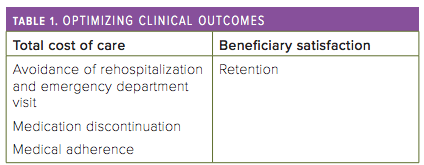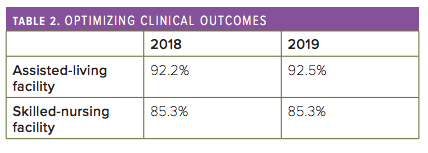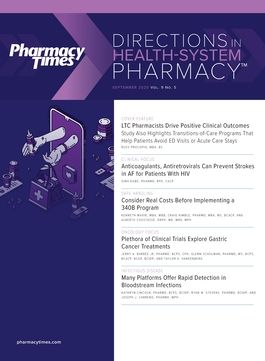Publication
Article
Pharmacy Practice in Focus: Health Systems
LTC Pharmacists Drive Positive Clinical Outcomes
Author(s):
Study also highlights transitions-of-care programs that help patients avoid ED visits or acute care stays.
A recently published study, “The Value of the Long-Term Care Pharmacist in the Delivery and Continuum of Care,” by Managed Health Care Associates (MHA), supports the notion that investments in long-term care (LTC) pharmacies are making in labor and technology to support the entire patient-resident journey are, of course, driving additional costs of dispensing drugs.
Further, the study presents an opportunity to highlight the transitions-of-care programs that MHA members have put in place to monitor and track facility admission and discharge medication reviews that typically result in the discontinuation of medications, as well as post-discharge telephone follow-ups that results show help patients avoid an acute care stay or a visit to the emergency department.
Definition of Long-Term Care
LTC has largely been undefined outside of market practice and various care residences; however, LTC pharmacists support the entire continuum of what is, aside from nomenclature, a fundamentally homogenous patient journey across these residences of care.
Drug Administration Model
The LTC pharmacist drug administration model differs vastly from other models in its required functions and activities, with fundamentally no difference between pharmacies serving assisted-living facility (ALF), medical at home, and skilled-nursing facility (SNF) beneficiaries. These activities and functions, specifically those related to beneficiary safety, clinical care, patient acuity, and operating requirements, drive capital deployment, incremental labor, and operating expenses.
Dispensing and Interventions Cost
Many LTC pharmacists supporting LTC beneficiaries have implemented additive and required processes and resources directly toward rigorous prescription regimen reviews upon a patient’s admission to a facility, during their stay, or at transition of care to a medical at home setting, in addition to post discharge from facility care. As of 2020, these prescription interventions have been shown to cost between $40 to $50 each, and transitions-of-care interventions between $15 and $20 per discharge. Notably, the results of a 2013 National Community Pharmacists Association study showing that LTC pharmacists’ cost to dispense was an average of $13.54, compared with the above figures, do not seem to take these additional investments in programmatic models into account.
These intervention activities have had a significant impact on beneficiaries as well as on plan or pharmacy benefit manager outcomes (see Table 1).

Excerpts from MHA Member Studies
The results of a 2020 analysis of the Partners Pharmacy Rx2Home program, targeting patients who received postacute rehabilitation and who required assistance with obtaining transitional-care medications and pharmacist counseling, show that 99.994% of more than 4000 discharged patients remained at home successfully.
“The Rx2Home program is having a profound impact in postacute care facilities. We are proud to offer this service with a focus on improving quality of life for our customers,” said Anthony Spero, the chief operating officer at Partners Pharmacy in Springfield Township, New Jersey.
The results of a 2017 study conducted by Consonus Pharmacy in Milwaukie, Oregon, showed that the pharmacy’s integrated electronic medical record/ pharmacist intervention model caused a 6% reduction in readmission rates to an acute care setting, in addition to 28% of all medication regimen reviews resulting in at least 1 discontinued medication.
“Not only has this integrated model provided benefit to the beneficiary, but we have seen through this study that with the new [patient-driven payment model/] facility reimbursement model, the facility reimbursement has increased $100 per resident,” said Neil Marshall, the president of Consonus Pharmacy.
Absolute Pharmacy in North Canton, Ohio, showed that over a 12-month period, 3834 prescription interventions were conducted across 20 facilities, resulting in 17% being clinically significant, which was defined as at least 1 medication being discontinued. This was according to results from a study the company conducted in 2019.
“With each year comes a new set of challenges when you take care of the country’s most acute and comorbid patients. This year, it’s COVID-19 and next, something else. The time is now for the industry to recognize the investment burden we take on to generate outcomes that the system needs to thrive,” said Kevin Fearon, RPh, chief operating officer at Absolute Pharmacy.
MHA Member Network Adherence Rates
MHA, in partnership with third-party Confidio LLC of Towson, Maryland, has shown its membership medication adherence rates for ALF and SNF beneficiaries over the past 2 years (2018-2019), using the medication possession ratio methodology (see Table 2).

Post—COVID-19 Outlook
In a 2020 MHA member survey, 72% of LTC pharmacists surveyed indicated an average increase in expenses of approximately 6% related to a post—COVID-19 world, specifically for personal protective equipment. We are also in a “sit and wait” mode to assess what additional federal, local, or state actions, activities, and/or requirements will shake out of this pandemic. These may also drive additional costs.
For a copy of the MHA 2020 Long-Term Care Study, MHA members may connect with their account representative or via email ([email protected]).
Russ Procopio, MBA, BS, is the executive vice president of longterm care pharmacy at Managed Health Care Associates, Inc, in Florham Park, New Jersey.
REFERENCE
Procopio R. The value of the long-term care pharmacist in the delivery and continuum of care. MHA Inc. 2020. Accessed September 2, 2020. https://www. mhainc.com/uploadedFiles/Content/Resources/MHA%20The%20Value%20of%20 the%20LTC%20Pharmacist%200720%20-%20final.pdf

Newsletter
Stay informed on drug updates, treatment guidelines, and pharmacy practice trends—subscribe to Pharmacy Times for weekly clinical insights.






